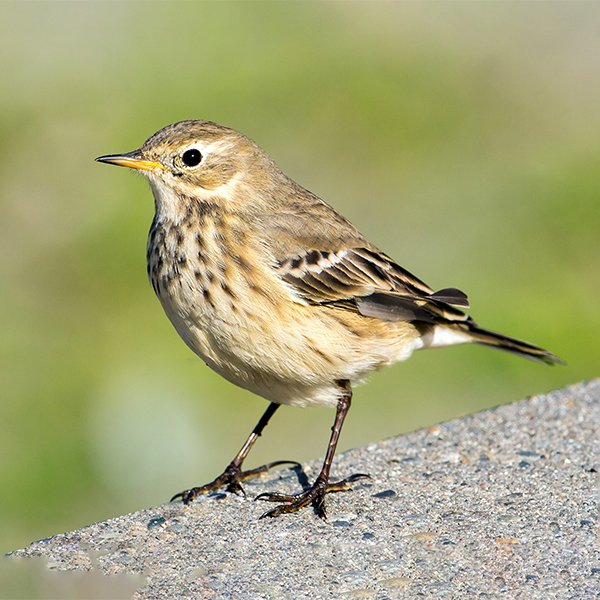Bird of the Month: American Pipit
Written by Andy McCormick
Andy McCormick, Volunteer and Former Board President of Eastside Audubon
Seen during September and October, the American Pipit travels in small flocks and is a regular fall migrant in Washington.
The American Pipit is a ground-dwelling bird of high latitude and high elevation (Alderfer). It prefers habitat with low-growing vegetation in both the breeding and wintering areas, which include plowed fields in spring and alpine meadows. Its legs are longer than those of most passerines and the combination of long legs and long tail gives the pipit a “jerky” look as it twists and turns in a seemingly random wandering in search of insects (Dunne). The pipit may flick its tail often and some think the white outer tail feathers may have the effect of stirring up insects (Bell and Kennedy). It is commonly seen in open areas.
The subspecies rubescens, from the Latin for becoming red, is the form most often seen in Washington in fall (Holloway). At that time of year, the pipit has a grayish-brown back; is whitish below with buffy on the flanks; and has dark streaking across the chest and along the sides. It has a white supercilium (eyebrow) and dark legs.
HIGH ELEVATION HABITAT
American Pipits are well-suited for northern tundra habitat and the short-grass meadows in mountain ranges. The alpine meadows of Mt. Rainier National Park provide good habitat for pipits. In late summer and early fall these birds can be found foraging around the edges of the remaining snow fields. Insects may become sluggish in the cold air near the snow and make for easier prey. Co-existing in pipit habitats are Horned Lark and Gray-crowned Rosy Finch (Dunne).
In the short, high north breeding season, American Pipits nest on the ground in short grass tundra. Incubation of the 4-6 eggs takes about two weeks, and the young usually leave the nest in another two weeks (Kaufman).
American Pipit
Scientific Name: Anthus rubescens
Length: 6.5”
Wingspan: 10.5”
Weight: 0.74oz (21 g)
AOU Alpha Code: AMPI
FALL MIGRATION
Pipits nesting in the far north begin leaving the breeding area in early September and migrate to California and the southern United States and central Mexico. It is thought that American Pipits withdraw from the breeding area in response to worsening winter conditions and will first move to lower elevation, then fly southward.
During the migration period which can last though October, American Pipits can be found in stubble fields, athletic fields, beaches, and other open areas. They can sometimes be seen mixed with shorebirds on mudflats or at the edges of ponds and rivers searching for insects. Fall migrants in Washington are more common west of the Cascades.
I found little information about pipits migrating in Washington in spring. It is possible those not breeding in Washington may make longer flights over much of the state to maximize their time during the brief breeding period. Pipits breeding in Cascade Mountain meadows will be away from most humans. It is known, however, that American Pipits arrive in the Okanagan Valley, BC by mid-April (Hendricks and Verbeek).
STATUS AND DISTRIBUTION
The American Pipit breeds in the Arctic from Siberia to Labrador and south to mountains in New Hampshire and Colorado. It winters in California and the southern United States to north-central Mexico. It is common and widespread in suitable habitat and there are no management or conservation plans in place.
However, the species may be at some risk due to climate change. The population of American Pipits in the Beartooth Mountains of Montana may be the best studied in North America. Here, there are estimates that alpine habitat may become more fragmented due to global warming. “The upper treeline in the Greater Yellowstone Ecosystem of Wyoming, Montana, and Idaho is predicted to move from 3,000 m to 3,300 m as annual temperatures rise. Such a scenario could lead to local extinctions of some American Pipit populations” (Hendricks and Verbeek).
A NOTE ON AMERICAN PIPIT TAXONOMY
Once considered conspecific with Water Pipit (A. spinoletta), American Pipit was split off 1989 as a result of identified genetic, vocal, and behavioral differences. Water Pipit retains its name and is primarily a Eurasian species. Pipits and wagtails have been placed in the Family Motacillidae and are characterized by long legs and an erect walk that helps them forage on the ground. The American Pipit is placed in the genus Anthus, which contains 42 species of pipits, and is named after the mythological figure who was killed by his father’s horses and then turned into a bird. Would that we all could be so endowed.
Photo credit Mick Thompson. References available upon request from amccormick@eastsideaudubon.org.



